Haiti’s recovery from the devastating January earthquake is far from complete. And the Asheville connection with recovery efforts remains strong. Mountain Xpress publisher Jeff Fobes attended a panel discussion held by the UN Association of WNC on Tuesday, June 22: Haiti: Past, present and future. Here are Fobes’ collected messages (Tweets) from the session.

Photo by Aaron Funk, a local relief worker recently returned from Haiti. For more of his photos see some of his work here.
———
Presenters included Tom Plaut (professor of sociology emeritus, Mars Hill College, and frequent point man on Mission Manna trips to Haiti); Will Davis (UN Information Center director in Washington, D.C.) and Jack Allison (chief of staff for the VA Medical Center in Asheville). The panel emcee was Lisa Sellers, Church World United, All Souls Episcopal. About 50 people attended the event, which was put on by the WNC Chapter of the United Nations Association.
Plaut travels regularly for MissionMANNA to Haiti; he’s a medical doctor, has served in the Peace Corps, and teaches at Mars Hill.
Davis has worked with the U.S. State Dept; U.S. Marshall Plan’s successor OECD in Paris; he’s now with UN Information Center in Washington, D.C.
Jack Allison is chief of staff for the VA Medical Center in Asheville; he served in the Peace Corps in Malawi and currently focuses on emergency medicine.
First up: Dr. Allison — “After [the] quake, I went to Haiti for the GCEE Foundation as an emergency-medicine doctor; most of Port au Prince was rubble.
Allison notes that Haitian time was and is in operation (things run slow); it takes hours just to commute; you work till you drop, then attempt to get “home.” Makeshift clinics are “political” because people with influence get the clinics placed where they want, he explains. The worst-hit area had a clinic that served 20,000 people living in tents; I also worked in a clinic in a sports center, situated under the bleachers. “We saw people who’d just been dragged out of the rubble; sometimes we made splints out of cardboard.
“Triage was the way we had to work; people lined up for blocks for treatment,” he continues. “We sorted for those with greatest need.”
One boy was brought in who’d been buried for a week, Allison reports. He was “floppy,” [near death] and his lips were near black. “We put an IV in the muscle of each leg because his veins were collapsed. We sent the child to Good Ship Comfort. Iwould have bet the child would die, but he recuperated, by the grace of God.
In another case, a nine-month pregnant woman’s water had broken: “I’d never done a C-section, but George knew [how, and] a Dominican Republican OBGYN nurse helped. At one point the nurse passed out. But we succeeded in the end; the baby was delivered.”
A third patient looked like she was 80; she had a bowel obstruction; a chopper took her to the Good Ship Comfort [the US hospital ship stationed offshore].
Next up: Will Davis, who noted what relief operations encountered on Jan 12 — 225,000 were killed; an additional 300,000 were injured; and 1.5 million were left homeless in a country of just over 9 million. There was no operational government; parliament had literally collapsed; most police stations were down; one-third of all civil servants were killed, [the quake having struck about 4:30 p.m.], crushing the best who were still at their desks.
And there were logistical challenges: no water, power or communications; roads blocked; no working airport working; and the port had collapsed.
The U.N. was the first responder and victim, suffering its biggest loss in its history, including the head of the U.N. mission in Haiti.
About 22,000 U.S. servicemen and women were subsequently deployed to help. The U.N. distributed 1 million gallons of water a day as well as food.
“Today, you leave Miami airport and after a short plane ride, you arrive at the Port au Prince airport, which is now functioning; order is being restored. … Haiti still needs a functioning government. The current head of state is ruling under emergency law. An election is needed; the U.N. will help.
“Security is needed; the U.N. has asked for an additional 680 French-speaking police officers to help. Half of the prisoners have escaped.”
An interim reconstruction committee (including the Haitian prime minister and U.S. President Bill Clinton) is organizing the rebuild efforts and coordinating it, he explains. A worry is that gang wars can resurface. A U.N. peacekeeping is helping rebuild the country and its schools. The goal: Build it back better than it was.
Haiti’s historic culture of corruption must be reduced, Davis continues. Haiti must build the capacity to feed itself. Land ownership patterns are problem.
He reports that $10 billion has been pledged by 40 donor countries over the next few years to help Haiti rebuild.
Plaut of MissionMANNA speaks next: “As a sociologist, I ask why children die; I think Haiti was historically set up to fail by France and U.S. I disagree with Will Davis to some degree; I work with children and don’t have happy stories. I’ve seen so many die.”

Here’s one of the Mission Manna clinics where Plaut and others volunteer in the Montrouis region. Photo by
In a slide presentation, Plaut notes the barriers to Haiti’s renewal: It has two tectonic fault lines through it.
One caused the January earthquake.
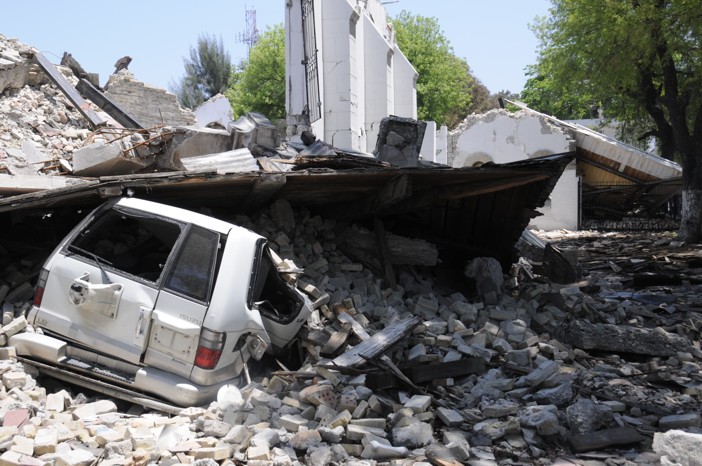
“Buildings just pancaked on themselves; people had no choice but to move into tents.
Rains can and do simply pick up modern concrete bridge supports and wash the bridge out, Plaut says.
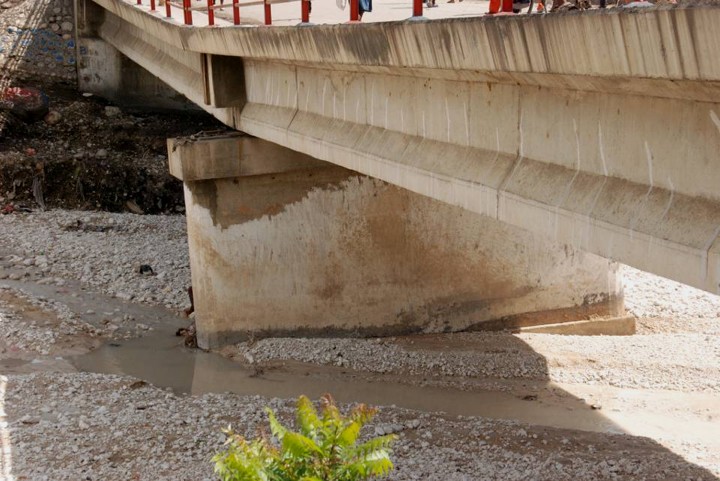
“— and this is on Haiti’s main highway,” Plaut adds.
Tropical storms will devastate the tents people are living in, he continues. “In most years, hurricanes and rains destroy major parts of Haiti’s fragile infrastructure.”
Further, Haiti’s top soil is being washed down the mountains.
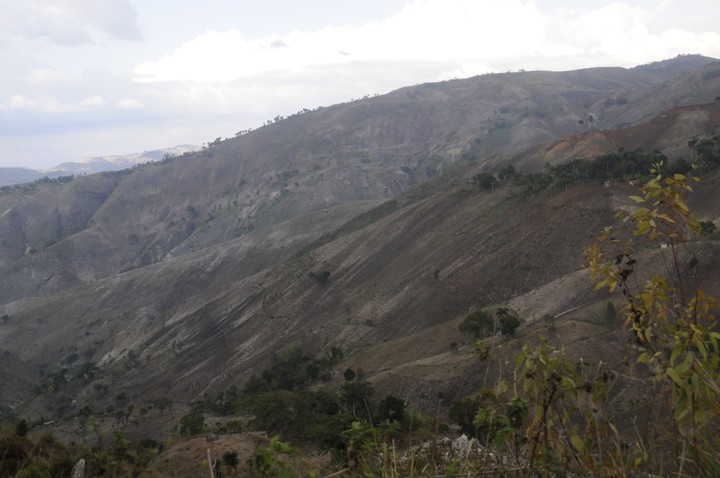
The Spanish and the French took the timber; and then the rest of the trees went for cooking. Haiti is 95 percent deforested, Plaut says.
Haiti has had population growth go from 2 million to almost 10 million now in 80 years. Hati’s population density is six times that of South Carolina. “A big question for Haiti: Is it sustainable at all?” Plaut asks.
As for infrastructure, Port au Prince has 18 sources of water — but none of it them are potable. There are huge pot holes (the size of a VW) on the country’s main highway. “The U.S. State department warns of crime; but I think potholes are bigger danger!”
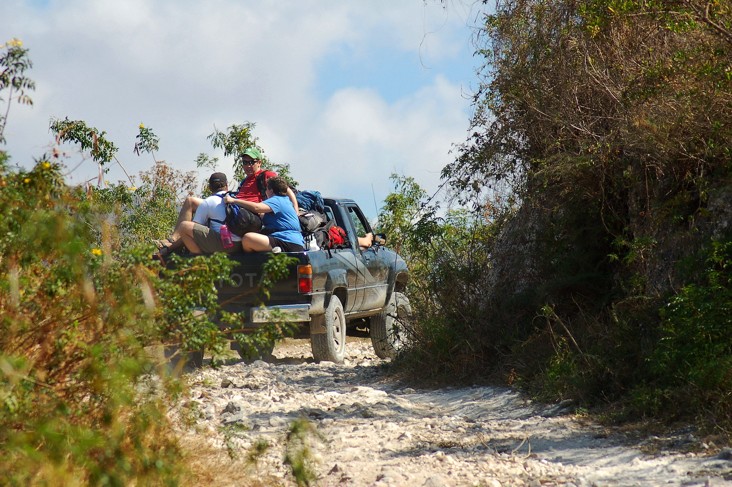
He also notes that hospital rooms have paint peeling off the walls, and many worn-out beds for patients squeezed together in each room.
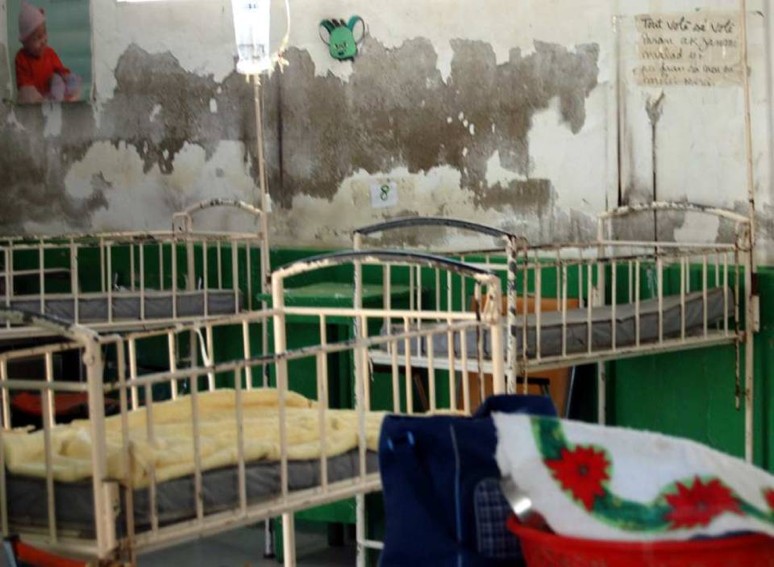
And this is in the main hosp in Haiti, he says.
At MissionMANNA’s clinics in the small town of Montrouis and in the mountains nearby, conditions are “so primitive, but it’s all we have in which to see hundreds of people in one day.”
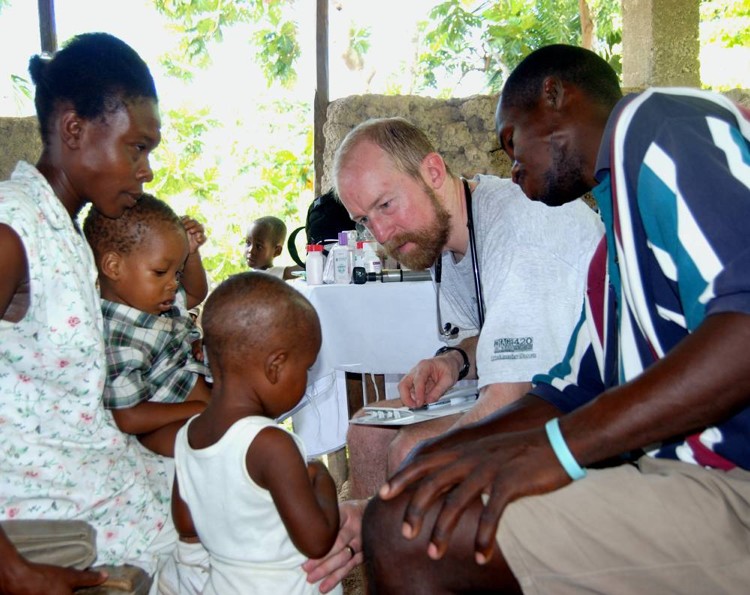
Operations are performed on a wood box covered with a garbage bag in one of the clinics in the country. Health care for most Haitians means this: “If you get sick you lie down; if you get well, you stand up; if you don’t — you die.”
In this photo, Dr. Derek Dephouse, with Asheville’s Mission Manna, sees patients in a Montrouis-area clinic.
The available water carries parasites; there’s malnutrition; and with all this, go opportunistic illnesses. Together they make the mortality for children 14 times higher in Haiti than in the U.S. Child mortality is four times higher than its neighbor, the Dominican Republic.
Foreign debt is also a barrier to development, says Plaut. He mentions “Odious debt” — money given to corrupt officials in Haiti, such as Baby Doc. He argues that this money never went to any moral purpose and the Haitian people shouldn’t be forced to repay it. Some people are calling for general debt cancellation.
Why is Haiti a debtor country? Basically because it had a slave revolt that succeeded and survived, Plaut continues. Haitian’s war of independence is great story; but the idea of a black-run country was anathema to white-run countries. Black-run Haiti was worse to 1804 the U.S. than Castro’s Cuba is to Washington today; the historical strategy not long after Haiti successfully defended itself from France in the early 1800s was to cripple it with embargoes, which were only lifted after France and the U.S. exacted enormous promises of payment — a payment much larger than the U.S. paid to purchase the entire Louisiana Territory! Haiti never recovered from the debt it incurred to buy off that embargo.
Yet, The New York Times still says that Haiti “mismanages” funds, making it sound like donors shouldn’t give them any more, Plaut says.
The average family annual income in Haiti is $1,783, compared to the U.S. average of $41,399 and the Dominican Republic’s $7,203. When a Haitian customs official asks me for bribe, Plaut says, I see a guy trying to figure how to get enough money to feed his family.
The U.S. has historically had heavy political, economic and military involvement in Haiti; most recently in 1994, it reinstalled Aristide. In 1984, the USDA determined the need to exterminate all Haitian pigs (for disease control); that indigenous pork was the main protein source, Plaut continues. The replacement, imported pigs never flourished in tropical Haiti.
Q&A part of the discussion begins:
Question: What are the opportunities to empower the people?
Allison responds: Get people involved; poor people need to be involved.
Plaut adds that the NY Times’ Robert Maguire in 2006 reported that the U.S. “is more exporting a kind of fear” than democracy.” In 2005, Plaut continues, the U.S. pressured Haiti to drop its tariff on rice from 26 percent to 3 percent and what happened was the country became flooded with “Miami rice,” destroying the domestic-rice market.
Corruption is part of Haiti’s fabric, Allision says. Though that’s not the true at the level of common folks. “The problem is with authorities.”
How to overcome the challenges and obstacles?
Allison mentions that the head of state didn’t spoke on radio to Haitians to provide leadership in the weeks following the earthquake. He notes he heard an authority say, “I never heard the term a ‘trusted Haitian’.” Once when we managed to secure a large allotment of food, water and tents, a mini-riot ensued because the tents were intercepted by the mayor’s office and put on sale on the black market; rice was put on sale too; and same with the drinking water.
Davis notes that this sort of chaos is what happens when you couple no infrastructure with no government plus corruption.
Question: What are the opportunities?
The incredible resiliency of the Haitian people is stunning, Davis says.
Allison notes that $750 million was raised by the U.S. Red Cross for Haiti. But he questions just how much of that actually got to Haiti? We don’t know. We need to know.
Plaut: The opportunities emerge when you work directly with Haitians on the ground and develop relationships; local leaders emerge; a grassroots-up is the best strategy and a source of hope.
Where [UNCA grad Amber] Munger is working, there is a women’s collective [Commune Anse Rouge]. There’s hope there, Plaut continues. When there’s so little money in an economy, something medieval happens; fiefdom happen; chieftains emerge.
There was a democratically elected government in 2006. There is a legitimate government, says Plaut. “We should remember that.”
Davis adds: “There are ongoing plans being developed by interim groups and authorities. But the Haitian government must be, in the end, the authority.
Haiti can successfully produce, using the 19th century agricultural model, Plaut says; but we must let the people of the country speak and decide what to do. Is Haiti sustainable? It works as a rural country; urbanization threw it into chaos, Plaut says. Farming is not popular with international development groups, he adds.
Allison: “Haiti is a cholera epidemic waiting to happen. And yes, we need to keep the spotlight on Haiti.
… Keeping the sense Haiti personal builds relationships; one of the things I have done is write songs that are being played on the local radio there to help Haitians survive (songs with lessons like ‘wash your hands with soap’)!”
Davis: Volunteer on the ground in Haiti if you can.
Allison: Keep personal relations with Haiti.
Question: What can citizens in Asheville do to help?
Davis: Give cash! Keep the spotlight on Haiti so the U.S. and attention doesn’t wander.
Plaut: At MissionMANNA, when we went to Haiti for our regular twice-a-year trip, we didn’t know what we’d find. But we had to go, so that we would be reliable and come through for the folks we’re working with. Also, tourism also can help Haiti — that, plus building on Haiti’s agricultural economy. Starting over can be the beginning of a new era for Haiti. “I’ve had Haitians say, ‘for some reason, we have more hope than we had before the quake!’”
“Talk to your congressmen and senators to get rid of Haiti’s debt and start a mini-Marshall Plan, says Plaut. Given our history, we owe Haiti all the help we can give them.
Davis: Improve our response teams. We have teams in place; we can build on these as a good model.
Plaut: There are women’s co-ops doing great work. And we need more cooperatives. But there’s a problem in Haiti with gender segregation; we met resistance trying to get female health-care workers in Haiti.
Allison: GCEE Fndtn is enmeshed in microfinance and plans on helping Haiti with small loans when things stabilize more.
Davis: Haiti after the quake was a nightmare: There was no infrastructure and no government. That was huge challenge for all aid organizations. Each time from these crises, though, we learn. So many schools collapsed; UNICEF has “schools in box” to bring in schools quick. When we were confronted in other emergencies with men receiving food and selling it on the black markt, the U.N. found a food-distribution solution: Give food vouchers to women; women are much more apt to make sure that the food gets to the people who need it, not to the black market.
When asked about education efforts in Haiti, Plaut notes that school kids in Haiti all need uniforms! And tuition fees are required! But families can’t afford this. Education isn’t free in Haiti, he says.
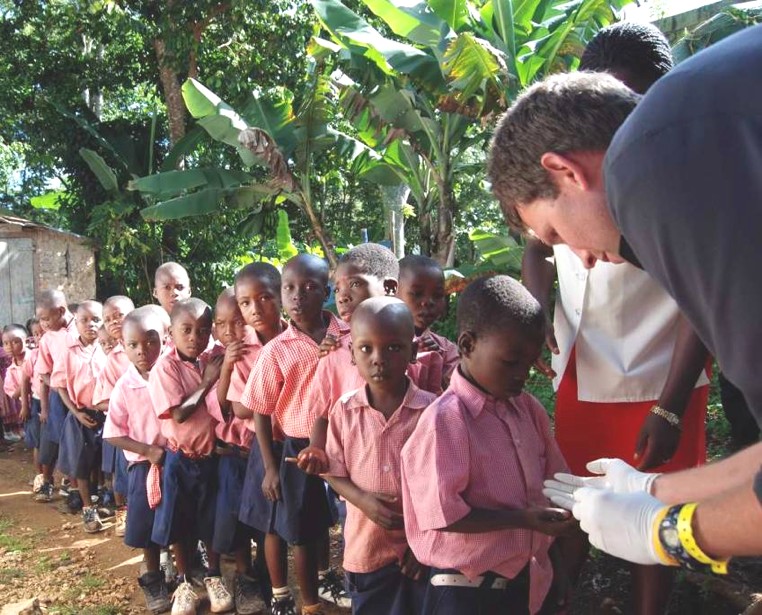
First photo by Aaron Funk; all subsequent by Tom Plaut.



Before you comment
The comments section is here to provide a platform for civil dialogue on the issues we face together as a local community. Xpress is committed to offering this platform for all voices, but when the tone of the discussion gets nasty or strays off topic, we believe many people choose not to participate. Xpress editors are determined to moderate comments to ensure a constructive interchange is maintained. All comments judged not to be in keeping with the spirit of civil discourse will be removed and repeat violators will be banned. See here for our terms of service. Thank you for being part of this effort to promote respectful discussion.